A commitment to crossbreeding works well for Simon Breen
Pages 6-7
Making breeding decisions for next season
Pages 8-9
Once-a-day wins in Galway
Pages 18-19

www.lic.ie
Irish students travel to LIC New Zealand Pages 2-3 and 10-13


A commitment to crossbreeding works well for Simon Breen
Pages 6-7
Making breeding decisions for next season
Pages 8-9
Once-a-day wins in Galway
Pages 18-19

www.lic.ie
Irish students travel to LIC New Zealand Pages 2-3 and 10-13

For the second year in a row, the LIC Research and Development (R&D) team had the pleasure of hosting University College Cork (UCC) students, this time Michaela Shorten and Sinead Johnson, between May and August. Their visit to New Zealand happily coincided with the National Fieldays ® , held near LIC’s headquarters. Both Michaela and Sinead enjoyed a day exploring the latest developments in agriculture and shopping up a storm for farm-wear to take home.
Michaela’s main project was working on one of LIC’s flagship trials, measuring methane and feed intake on 400 purpose-bred yearling dairy heifers. This piece of work aims to validate that measuring methane and feed intake in young bulls, to identify low or high emitters, results in daughters that also differ in methane emissions.
These same animals will also have methane emissions measured in their first lactation, in August 2025. The heifers travel to the Waikato based, Tauwhare methane barn in groups of around 100 heifers and stay in the barn for a 40-day measurement period. Michaela’s role saw her assisting with the day-to-day animal care, and monitoring data flows and quality.
All heifers have a rumen sample collected in week 5 of the trial, via oesophageal tube, so the microbe population in the rumen can be defined. Michaela was trained to collect samples, and successfully collected more than 20 rumen fluid samples. She fitted in seamlessly with the team and made a positive contribution to the work being done.
Sinead participated in a wide range of tasks that highlighted her adaptability and intellectual curiosity. She joined the Sire Analysts on dam Traits Other Than Production (TOP) inspections, learning to score potential contract dams for conformation traits. She then contributed what she learnt to sirematched mating suggestions for elite Embryo Transfer (ET) donor dams.
Sinead also gained practical experience in the Vytelle laboratory, where she engaged in the Ovum Pick-Up (OPU) and fertilisation process, with elite
heifers. This further enhanced her understanding of Livestock Selection practices where she was able to work deeper in the analysis of the data producing reports for further analysis. Sinead’s contributions left a lasting impact on the Livestock Selection team, and she has shown great
potential for success in her future endeavours within the field.
LIC has had a long-term science relationship with Frank Buckley when he was at Moorepark and now at UCC. Several years ago, LIC’s Chief Scientist Richard Spelman and Frank discussed and identified the benefit of having Irish students undertake a 12-week placement at LIC to work in the R&D team. The R&D team has a good track record of student internships as they host 6-10 NZ students each year for summer internships. The LIC team hope to welcome more Irish student interns in future years.
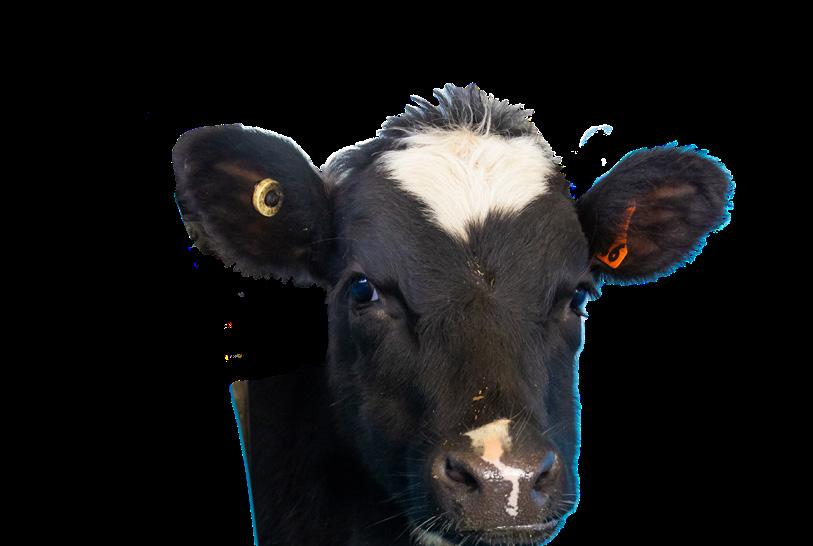
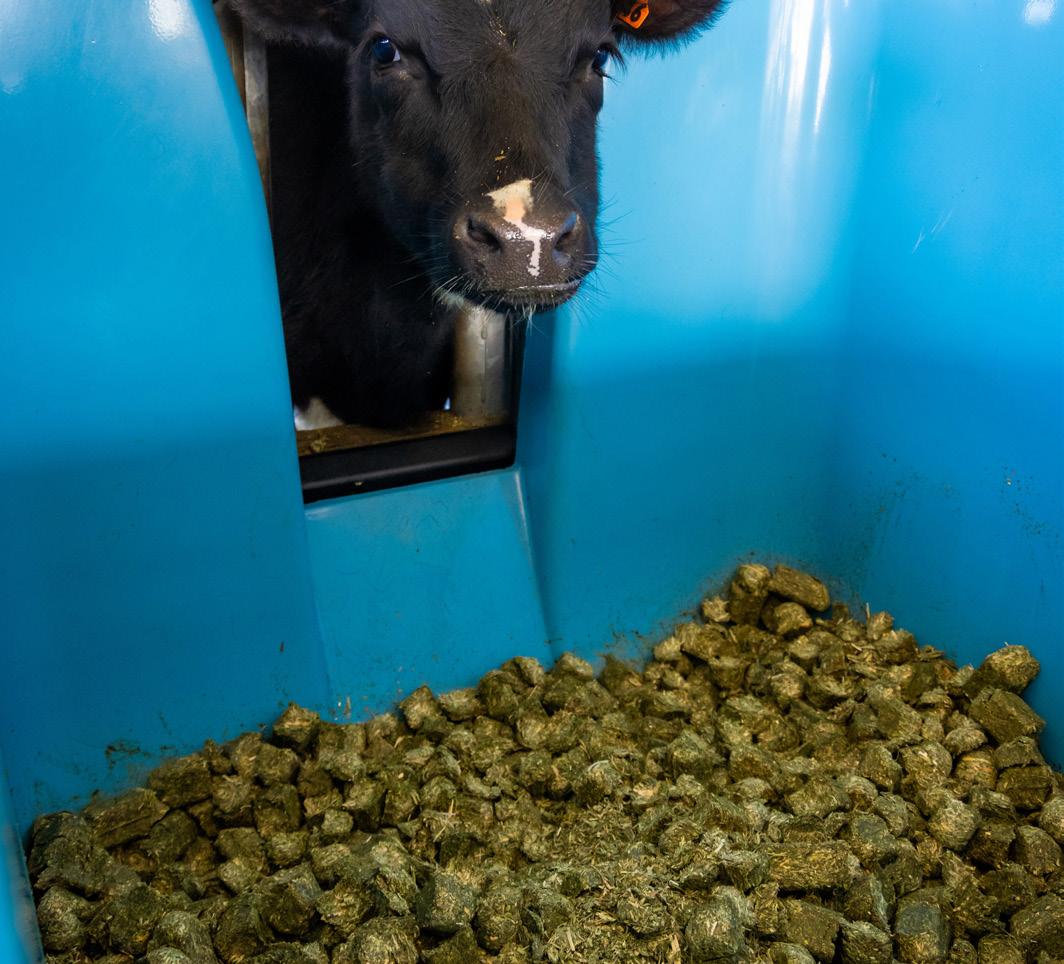

When picturing the ideal cow, each of us may have something different in mind. But for an Irish grazing system we need to look for efficiency of production from every cow in the herd. That is, a cow who efficiently delivers a high amount of milk solids per kilogram of liveweight, with very little fuss, while quickly getting back in calf year-after-year.
While facing many external pressures, Irish dairy farmers mustn’t lose sight of the importance of efficiency - both from our cows and from our farming systems.
Efficiency underpins profitability and is especially important in the face of ever rising input costs and a volatile world market. Genetic gain keeps this moving forward, delivering ever increasing feed conversion efficiency.
Production data and actual liveweight information can be used to help farmers identify the most production efficient cows in their own herd and farm system.
Discovering the opportunity for the future within the herds of today
There is an exciting opportunity within our herds right now as we recognise the potential for our future herd! The production and production efficiency variation seen within animals in the same age group in the herd, gives us a glimpse of the potential for whole herd performance in years to come.
LIC quantified this for 3376 NZ herds in a 2023 study of mature (4–8-year-old) cows. The study showed a strong relationship
between production efficiency and genetic merit (gBW) at +0.4 kgMS per 1 gBW increase. There is significant variation in performance within herd age groups. The performance difference between the top quartile and the bottom quartile of mature cows within herds averaged 166 kgMS/year, while the genetic merit difference was 64 gBW points, (see Table 1).
The top quartile cows were around 30% ahead of their bottom quartile herd mates for milk production, production efficiency (kgMS per kgLWT), and genetic merit (gBW), revealing the exciting opportunity farmers have to further improve performance, just by breeding and milking more of these top end cows. The
proof is there - high gBW bulls breed high production and production efficient cows.
All of this highlights once again the usefulness of milk recording. Combined with liveweight information from annual cow weighing in mid-lactation, farmers can identify the most and the least efficient animals in their herds. The contribution of liveweight to production efficiency isn’t anything new for farmers who have long had their eye on that key metric. They know that larger cows cost more in feed for growth and maintenance. Taking nearly an extra 300 kgDM to feed a 600 kg cow vs a 500 kg cow each year, that’s the equivalent of an extra two silage bales required per cow, per year. Recent Irish research confirms the usefulness of this as a production efficiency measure.
Actual liveweight data will highlight the most efficient animals in your herd. The ICBF has recently launched a new online tool to calculate efficiency once you’ve entered in your cows’ mid-lactation weights. This will make it easy for farmers to select their most efficient animals for breeding.
And she needs to be highly fertile
When we’re looking at efficiency, it’s the smaller more productive animals that are most efficient, and these tend to be our crossbred animals. We’ve seen this both in New Zealand and in Ireland.
While we can breed for efficiency within any breed; Holstein Friesian (HF), Jersey (JE) or Jersey-Holstein Friesian crossbred (HFxJ), it’s the HFxJ group of animals that have proven to be most efficient. In Ireland, research conducted by Moorepark, has shown that HFxJ animals (animals with more than 25% Jersey) produced 8.9% more solids per kgLWT when compared to HF across all parities (1.01 vs 0.92 kgMS per kgLWT).
The HFxJ group also maintained that efficiency into later lactations, whereas the HF hit peak efficiency in their third lactation (0.96 kgMS per kgLWT) and started to decline thereafter.
The end result was that the HFxJ group produced more kgMS per kgLWT across more lactations than the HF group, and they showed a linear increase in efficiency with the proportion of JE genes in the animals. (A link to the research is at the bottom of this article, or talk to your LIC breeding advisor)
Source NZ Dairy Stats 2022/23
High genetic merit HFxJ cows show the greatest production efficiency and maintain that efficiency for longer. Therefore, crossbreeding is an invaluable strategy to increase efficiency in your herd.
Nevertheless, no matter your chosen breed, higher gBW consistently delivers greater production efficiency. In an LIC 2023 study, similar to the previously mentioned study, more than 840,000 cows with over 200 days in milk in 2022/23, were ranked by quartiles for genetic merit (gBW) within breed and assessed for production and other traits. Again, across every breed or breed mix the top quartile animals outperformed their lower gBW herd mates. On average, they produced more milk solids, were lighter in liveweight and had higher fertility breeding values, with
the trend being consistent through the quartiles.
So, it’s clear that using high gBW bulls will increase the efficiency of your herd and help you breed more efficient cows faster. As input costs rise, increased efficiency is vital to continued profitability.
Using herd improvement tools, such as milk recording and capturing mid-lactation liveweights you can select your most efficient and fertile cows, breed them to high gBW bulls and step up to even greater levels of efficiency in your herd.
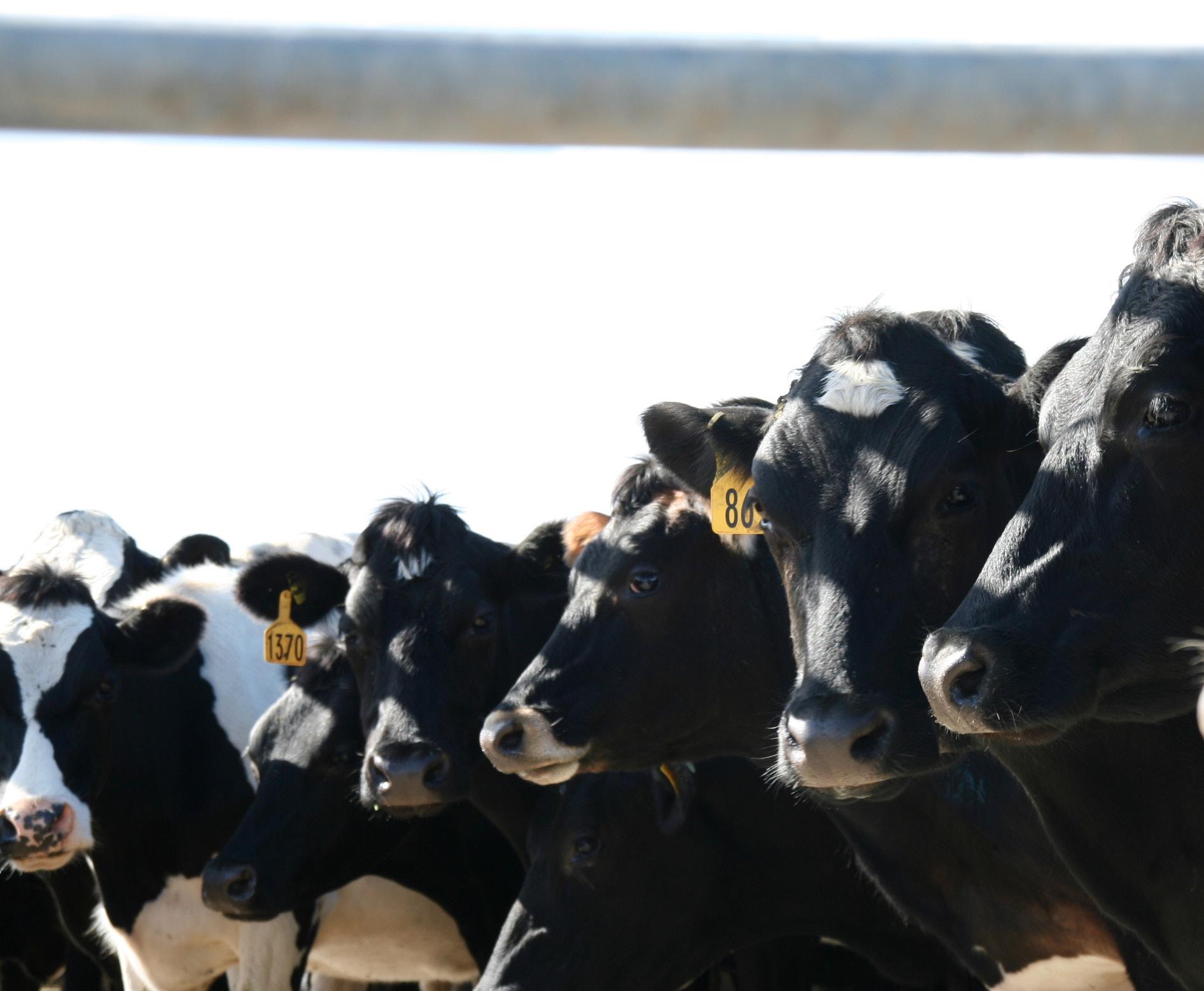

Twelve years of crossbreeding are paying handsome dividends for the Breen family who farm in Emly, Co Tipperary. The farm’s 260 Jersey crosses are performing well despite a completely unexpected disease outbreak that was difficult to control without costly intervention.
More than 300 farmers attended the recent open day at Galtee View Farm. Producers were eager to learn how labour efficiency, selecting the right cows for the system, continuous herd improvement, and strategies to de-stress the business and improve lifestyle have helped Simon and Carol, along with parents Peter and Sheila, run one of the most efficient units in the area.
The total area farmed is 115ha with a milking platform of 89ha, a milking platform stocking rate of 2.92 cows/ha and an overall stocking rate of 2.26 cows/ha.
Included in this total area are two other farms, one located five miles away and the other three miles away, both used for silage production. All calves are reared off the farm on a rented block, with the one and two-year-old heifers contract reared by Eamonn and Mary Callanan. The heifers return to Simon in-calf, and those not in-calf are sent straight off to market to be sold.

Simon aims to get the herd up to 4.5 lactations/cow, at the moment he’s at 3.7. As the trade for in-calf heifers was poor last autumn, he kept all these heifers and pushed out some of the older ones.
“I’m not trying to keep the herd young, but I had to move the older cows out or I was virtually giving away very good high genetic heifers,” he says. The herd grew by 11 extra cows in 2024 as a result.
The family are very aware of how difficult it is to keep staff, so they aim for a real team spirit culture on the farm. Other part-time members include Kenneth Purcell, Paddy Walsh and Conor Burke, with Simon keen to give anyone a chance if they work hard and do their best.
“I’ve looked at rearing the heifers myself again on one of the out farms, but then Eamonn and Mary are doing a really good job and provide both land and labour. The possibility of losing the nitrates derogation is also a consideration. When you have a good team, as we have here, you need to keep hold of them. I have loads of different people and contractors doing different jobs, it’s a bit like a jigsaw, and I have to pull it all together!”
Simon is involved in what he describes as some very progressive discussion groups, a local Emly/Tipperary group, a lowcarbon dairy farm group and the DairyMis group based out of Moorepark. It was here, where a lot of positive results were coming from trials on cross-breeding, that he decided to move forward in this direction with his herd.
The first cows Simon worked with were black and white, with a lot of Holstein blood. He started to use some New Zealand Friesians, then moved towards Jerseys. “The larger type of cow just wasn’t suiting our system,” he says.
When he started with the Jerseys, Simon was worried about keeping the calves alive as they were so small, but soon found out they were easier to rear than the Friesians.
“I liked what I saw when the first heifers came into the herd, the solids were going through the roof. On advice from LIC/ Eurogene, we started using KiwiCross® bulls on the crossbred cows and later moved to sexed semen. Since then, we haven’t looked back.”
He uses Belgian Blue bulls to produce his beef calves and has a local purchaser who buys them all. “He took 125 calves in one day last year!”
All was going well at the Emly unit with Simon’s herd earning a five-star ranking


on fat, protein, milk price, 6-week submission rate and EBI. The empty weight across the herd was less than 10% consistently, and with cow weight of around 487 kg, herd efficiency was sitting at around 1 kgMS per kg of liveweight.
The spring calving unit had 93% of cows calving in a six-week window. Producing 449 kgMS/cow, feeding just 540 kg/meal per cow meal at 4.93% fat and 3.84% protein (2023).
But in spring 2023 his herd were hit with an outbreak of pastuerella multocida pneumonia, an unusual illness in dairy cows, and one more often seen in young beef animals. The cause of the outbreak remains a mystery, but more than 50 cows were treated in February and early March and the herd seemed to recover well.
“The vaccine is very expensive and, as no other cows were sick after the spring outbreak, we decided with the vet not to vaccinate” remembers Simon. “There were no problems in spring 2024 but then at the end of May cows started to show signs of being sick again – recording very high temperatures. So, we decided to vaccinate the whole herd,” he says. No animals died, but fertility was affected with some cows losing embryos.
However, overall fertility performance is excellent, despite the disease outbreak, and this spring the six-week calving rate was 95% and the three-week submission rate was 97%. After 10 weeks of breeding with AI, only 10% of the cows scanned empty.
Today Simon only breeds for 10 weeks (rather than 12) as he says the cows coming into the herd have good genetics for fertility. In addition, he puts any latecalving cows on to once-a-day milking until they’re bred.
He aims for 70 heifer replacements; 50 replacements are kept, with 20 sold. “My discussion group told me I should keep rearing this number of heifers as, although the price might not be right now, in time the trade should improve!”
The weather has had a big impact on Galtee View Farm in the past 12 months. “It started raining here in July last year and it didn’t stop.
“By April 1st this year I’ll never forget how fed up I felt. It was a bank holiday and everyone else was off for the weekend. The weather here was atrocious. The grass quality was atrocious. The cows were inside. I’d just had enough.
“I started to ring a few friends of mine for a bit of a chat, bit of a morale boost. I could see how fellas got depressed. I just needed to talk to someone. And these guys were in the very same situation as I was. One chap said I was the second person to ring him that day and admitted he had rung a friend of his earlier in the morning for the same reason, he needed a bit of a blowout.
“But then the weather improves, and we can get back to work. All farmers love their jobs, but sometimes it’s really hard


Now Simon feels that he is at a crossroads. He’s unsure whether he will be allowed to maintain current cow numbers (nitrates derogation) or if he will be forced into a lower stocking rate. Either way, he plans to focus on increasing milk solids rather than volume.
“Farming is tough, sometimes it’s difficult to know which way to turn. “But I love the job, and would never do anything else,” he adds.


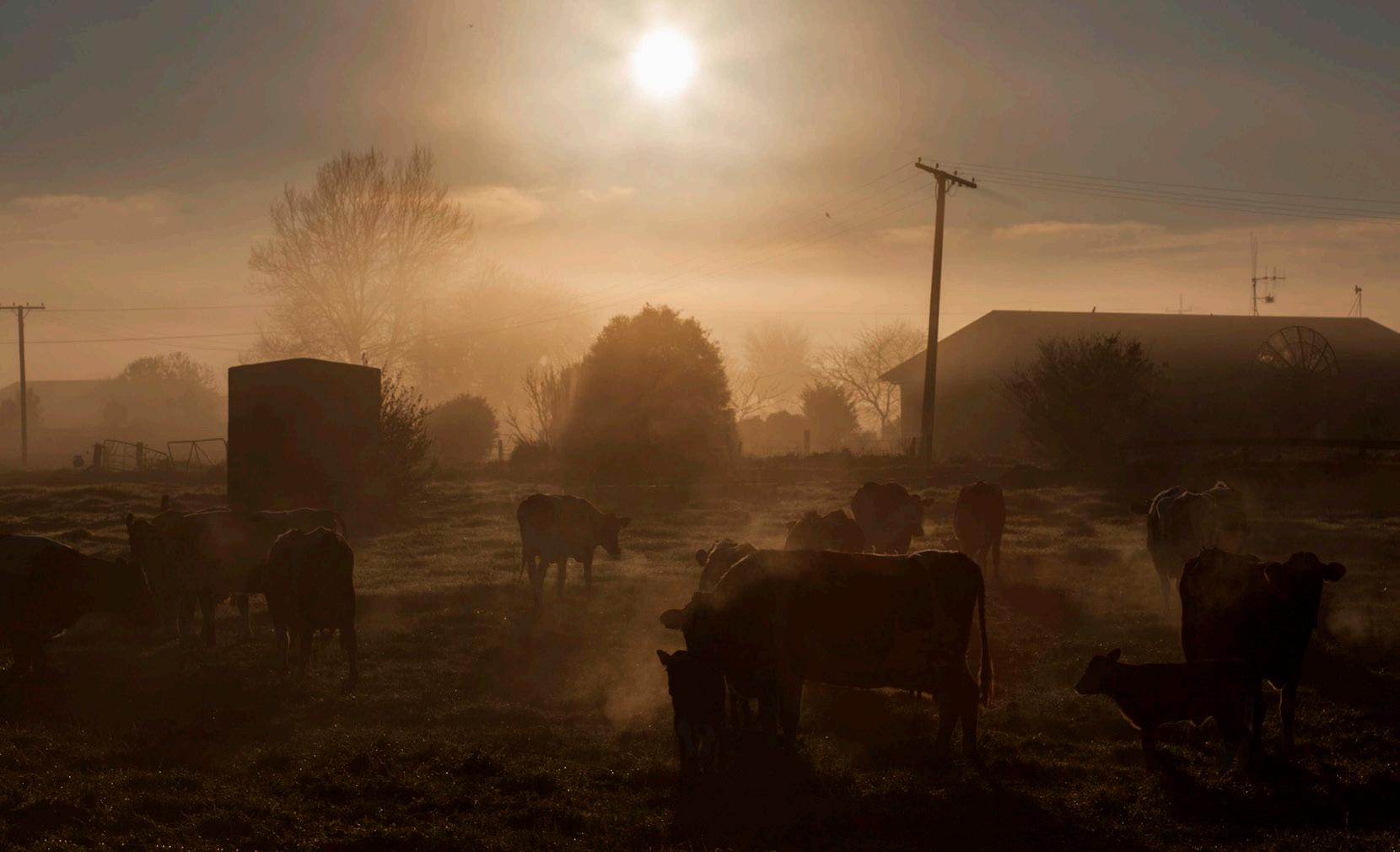
With farms this year experiencing reduced grass growth, it’s important to cull underperforming animals and reassess your stocking rate on farm. Matching feed demand with feed supply is essential, as buying additional feed can be expensive - especially when it is used to support animals that are not contributing effectively to the herd.
Some farmers have been shifting their focus away from breeding for the most efficient cow for their system. This move has been mainly driven by concerns over the number of surplus calves being produced on farms and the ability to sell such animals going forward.
Firstly, it’s crucial that farmers continue to focus their attention on breeding an appropriate cow for their system. Neglecting this in pursuit of a ‘better quality calf’ can be counterproductive. Solve the surplus calf issue by taking more care over selecting the appropriate beef sires to use on cows not producing your dairy replacements. This will have a much better result than altering the breeding choices being made with the type of cow you are
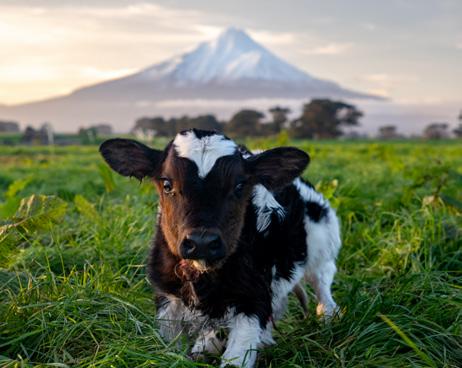
trying to breed. Damage can be done by introducing the wrong genetics in one generation. Care must be taken to avoid this.
This spring brought its own challenges with the weather, and the knock-on effects have impacted milk production, breeding and feed stocks around the country. For example, the weather put pressure on the sale and movement of dairy x beef calves in the spring.
While farmers are in the process of scanning now, we would encourage producers to take stock of feed availability for the spring and be mindful of closing covers, as well as body condition scoring cows ahead of winter and start preparing for next spring.
Despite the challenge of weather as well as other external pressures, we’d encourage farmers not to lose sight of their herd improvement goals. You can accelerate your herd’s genetic gain by identifying the cows that perform best in your system and by breeding replacements that are able to efficiently produce milk solids profitably and efficiently from pasture. To do this, farmers need to select and breed animals that are genetically better than the previous year’s line of replacements.
Farmers have a number of levers to pull to achieve this:
• Keep accurate herd records
• Weigh animals to determine production efficiency
• Conduct milk recording
• Keep accurate calving and health records
• Ensure accurate parentage
Good reproduction performance
• BCS targets
• Health and nutrition
• Good heat detection
• Tight calving patterns
Culling
• Empty cows
• Late calvers
• Problem cows (high SCC, poor feet)
• Low production cows
Cow selection at mating
• Breed replacements from your best cows
• Use beef on below average cows
Sexed semen
• Allows for more replacements to be bred from the best cows and heifers
Heifer mating
• Mating heifers to sexed semen allows for greater genetic gain as heifers should represent the best genetics in the herd
Here are some bulls that the team would like to highlight for early-ordering:
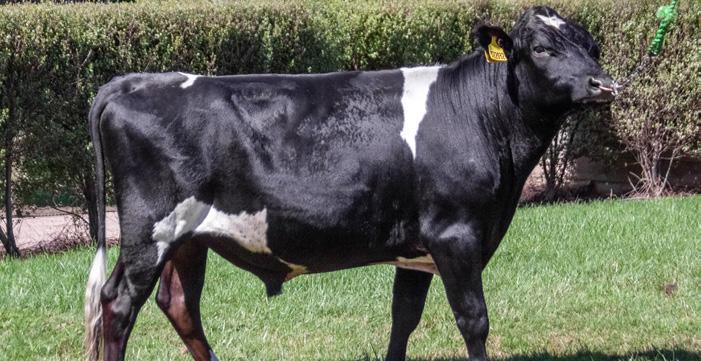
Bred by Chris and Dianna Rogers from outside Taupiri in the Waikato region, Dreamer is yet another outstanding genomic bull available to LIC for the coming season.
With a liveweight of -2 kg and a total of 69 kg of solids, it’s easy to see where he gets his gBW of 491 - efficiency in abundance. Dreamer comes in with milk solids of 10.4% and when you look at his pedigree, it is easy to see why.
He is bred from an outstanding Blackhawk dam, who produced 510 kg solids in her second lactation at 7.16% fat and 5.27% protein.
Sired by Werders Premonition, who himself sits at 10.1% solids, you can see how it’s easy to see the solids oozing from this mating. On top of his production, Dreamer also sits nicely with 3.4% fertility. Add to this his capacity of 0.6 and udder overall of 0.88, and this easy calving bull is certainly one that producers should be using in the coming season.

The highest Friesian gBW heterozygous polled bull available in NZ. Around 50% of calves born don’t need de-budding, saving you time during a very busy period. He has an excellent back pedigree, sired by Meander SB Arrow-ET, with a dam averaging protein of 3.97% and butterfat of 4.80%.
Monopoll brings fertility and production along with great udders and overall dairy conformation. A bull for all farms in 2025.



This bull has something special, and his daughters are proving it with their performance on the ground. Flash Gordon is reaching new heights for production traits among the KiwiCross® bull team. He has a whopping 107 kg of milk solids on BW and has components of 4.1% protein and 5% fat. With excellent udders, great capacity and positive for fertility, Flash Gordon would be a suitable bull for any Irish dairy farmer wanting to ensure progress within their herd.

This is a bull who made his debut in the LIC catalogue last year, and with limited straws available, he was fully booked up before the season got underway. He is a very impressive KiwiCross® bull boasting strong protein and fat percentages (4.1% and 5.5% respectively) and brings over 90 kgMS.
This medium sized bull will breed efficiency into any herd. With a 0.96 capacity score and an udder overall score of 0.6 from the 99 daughters TOP inspected, he’ll breed some hefty cows with strong udders.

The first son of Lightburn Blade Gusto to have become available to Irish farmers, Goldmine is an exciting prospect from the 2022 intake of bulls. A combination of excellent production, fertility and type, here’s hoping Goldmine brings it all to the table with his progeny. Some impressive gBV numbers include a combined fat and protein of 88 kg, 659 L of milk along with an udder overall of 0.77, capacity of 0.45 and a cracking fertility score of 7.0%.
His sire, Lightburn Blade Gusto is a 15-code bull and has been a part of the Premier Sires™ team for 6 years. His dam, an outstanding cow, is currently in her fourth lactation. She hasn’t missed a beat in terms of calving interval! This winning combination should prime Goldmine to leave a lasting legacy like his sire.
Frank Buckley, Professor of Agricultural Science (Head of Discipline) and Academic Director CK412, describes how the unique curriculum of Agricultural Science at University College Cork (UCC) equips students for success in the Agri-Food industry.
Agricultural Science at UCC (CK412) was established in 2019, initially with an entry limit of 25 students which has now grown to over 30. It is co-delivered through an integrated partnership with our expert colleagues (research and extension) at Teagasc (primarily Teagasc Moorepark but incorporating experts throughout the organisation, including at Clonakilty Agricultural College).
The result is a unique and unparalleled curriculum combined with several unique selling points that set CK412 apart. We set out to attract Ireland’s brightest and best students seeking to pursue the study of Agricultural Science at the third level, and we are fortunate to be achieving just that.
The programme is proving to be a
resounding success having quickly earned a very positive reputation –based on student satisfaction, external feedback, and consistent high demand. Our graduates are in high demand right across the industry and over time are set to assume leadership roles across the Agri-Food sector in Ireland –primary producers, research, education, consultancy, banking, milk processors, breeding companies and so on.
Through my research interests in the genetic improvement of Irish dairy cattle, I have enjoyed a longstanding relationship with LIC in Ireland. It was during one of my many catch-ups with LIC’s, Mark Ryder that the opportunity to undertake industry placement abroad with them in New Zealand came to fruition. And it’s proved to be an amazing opportunity. I’m sure
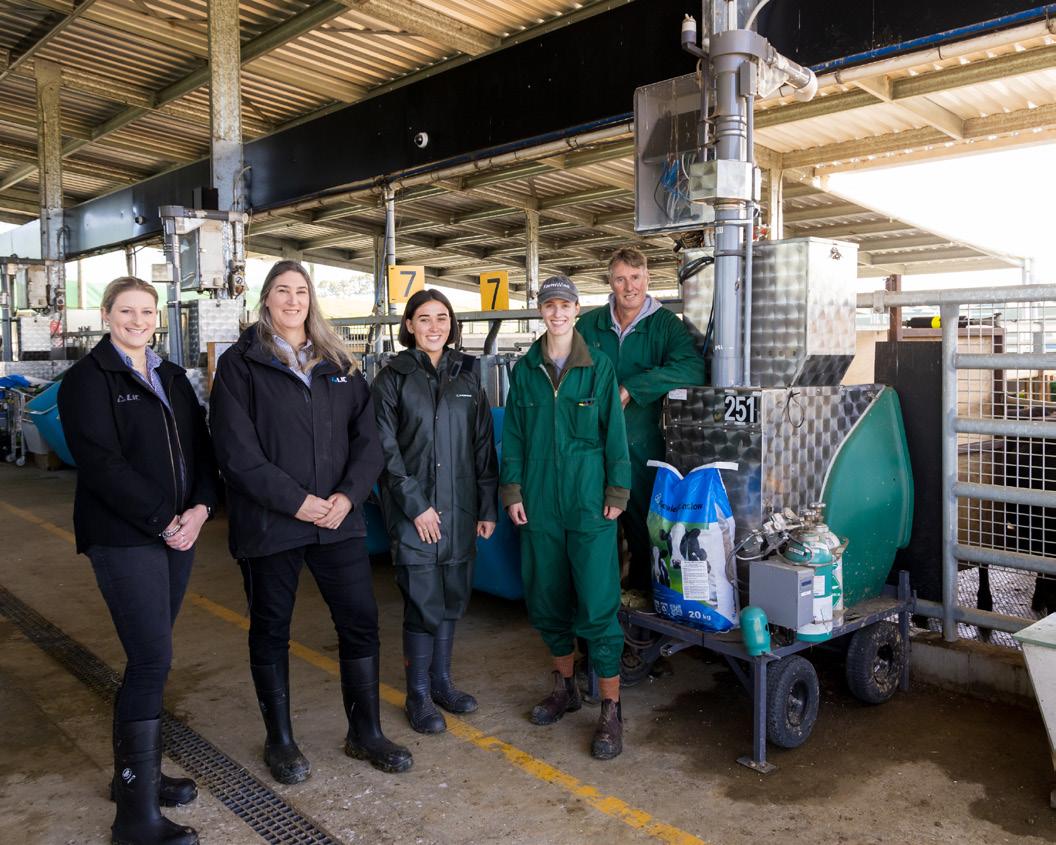

you will have gathered that from the students who have taken part.
The students who have travelled as part of this opportunity have not been disappointed. They’ve been treated very well and enjoyed a fruitful learning experience.
All our students undertake a total of 29 weeks of paid work placement during semesters two and three (January to August) of their third year – 17 weeks with one of Ireland’s highest performing dairy farmers followed by 12 weeks in the industry – both tailored to individual student interest, previous experience, and ambition.
Firstly, the students are placed with the best, often award-winning dairy farmers during the busiest time of the dairy farming calendar. During this time, the students will deepen their knowledge, experiencing all the aspects of the day-to-day management of an intensive, highly efficient, profitable, and sustainable dairy farming operation.
Topic-specific block release days, hosted by key experts, complement the placements and help students get the most out of their farm work placement.
Later in the summer, there is an opportunity to work alongside key industry stakeholders and agribusinesses. This opportunity is particularly important for providing an essential transition from university to the professional work environment, connecting our talented, well-educated, and ambitious undergraduates with leading Irish and International agrifood companies seeking to employ Ireland’s future industry leaders.”
I’m a final year agricultural science student at University College Cork, Ireland, joining LIC’s Research and Development team for 12 weeks between June - August 2024 as part of my university placement.
I worked alongside Senior Scientist Dr Lorna McNaughton and the team on the low methane emitting cattle project. I spent the majority of my time working in the methane measurement facility on LIC’s Tauwhare Farm, in the Waikato region. The part of the trial that I was focused on was measuring the methane emissions and feed intake of 398 yearling dairy heifers. The heifers were divided into 4 groups with each group entering the trial for a period of 40 days. I was involved with two rounds in the trial – round’s two and three. The methane emissions are measured in two ways, using a GreenFeed machine that the animals can access 5 times a day and breathe into with pellets luring them in. The other method is using the Cattle AgPAC chamber, where the heifers spend 45 minutes in the sealed chamber in weeks four and six of the trial.
Assisting with day-to-day

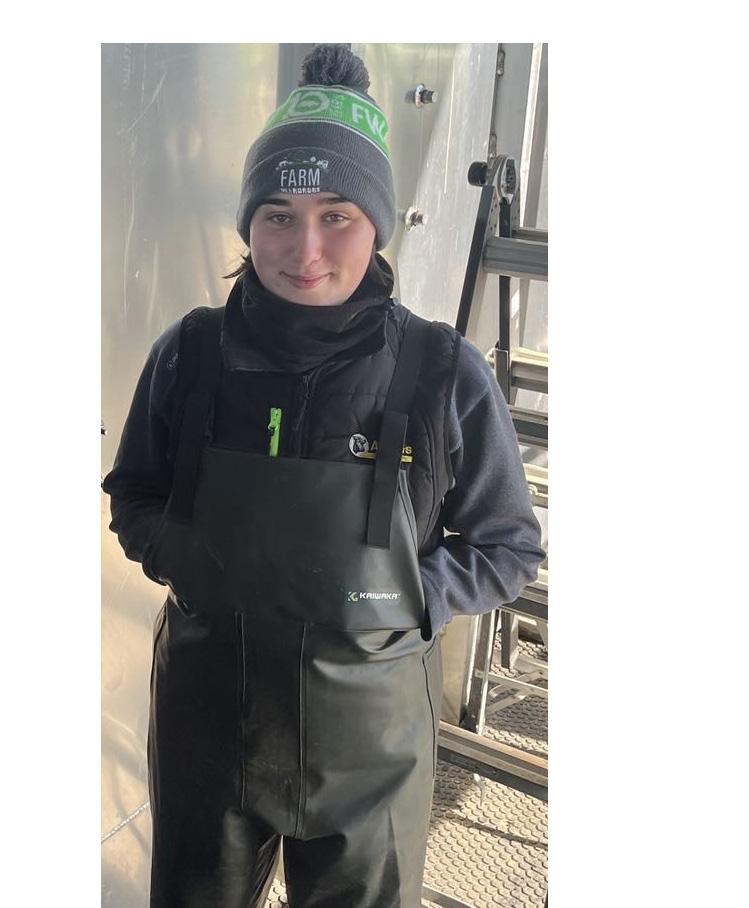

animal weighing, bedding and feeding, identification of health issues and assisting with animal health treatments. Data collection included monitoring heifer feed intakes, rumen fluid collection, plus collecting and monitoring gas measurements from the AgPAC Chambers.
I spent one or two days a week in the head office in Newstead where I analysed feed and weight data from the ongoing methane trial and worked on my university report. I also had the opportunity to visit the LIC Innovation Farm which was intriguing.
I’m sincerely grateful for my time spent with LIC and the opportunity to work alongside the R&D staff. It was such an amazing and rewarding experience to see first-hand the hard work and dedication that happens in the background of research trials. Moving forward, I’m committed to advancing my knowledge and skills in the field of ruminant nutrition and reproduction through further study.”
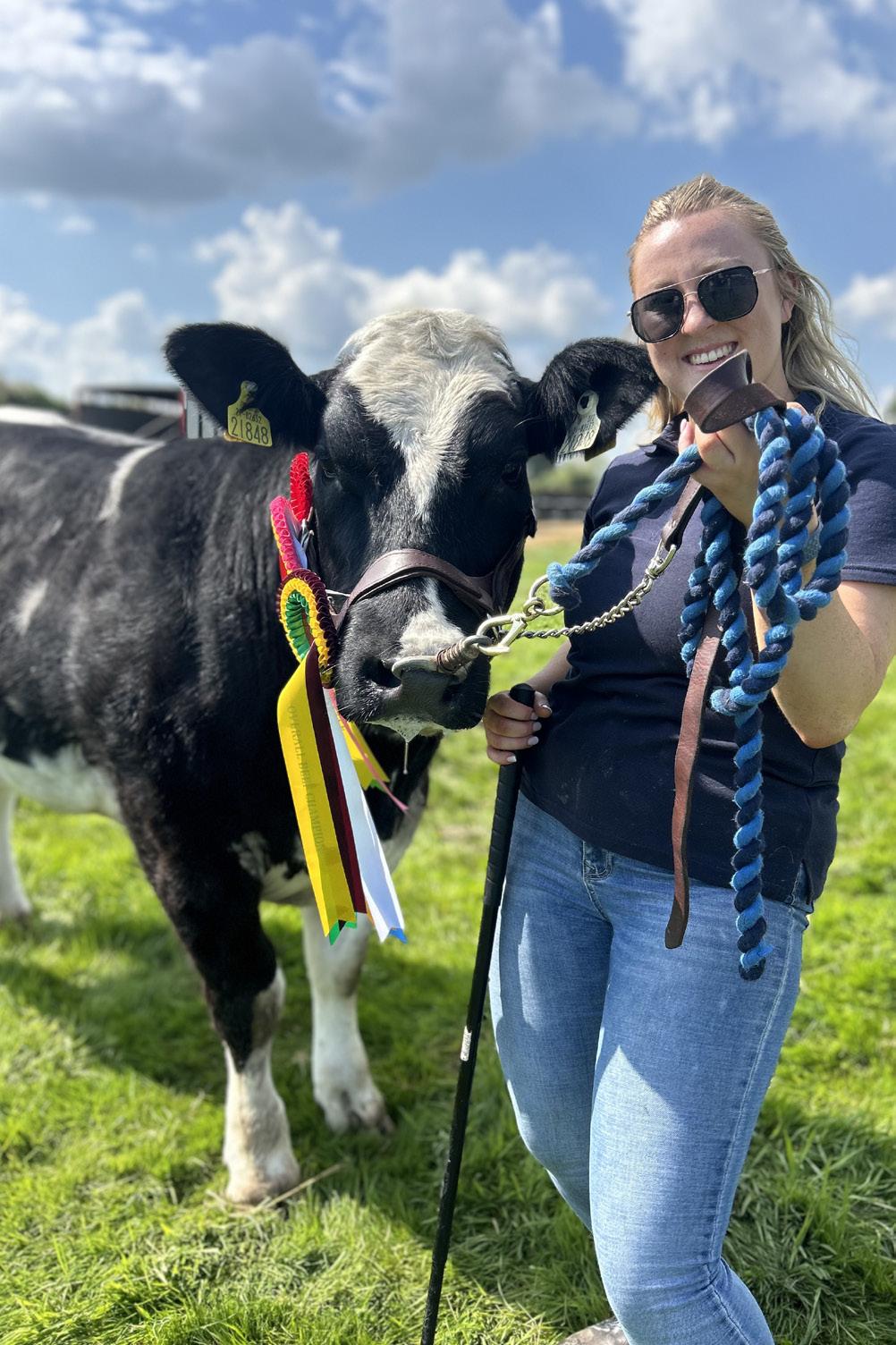
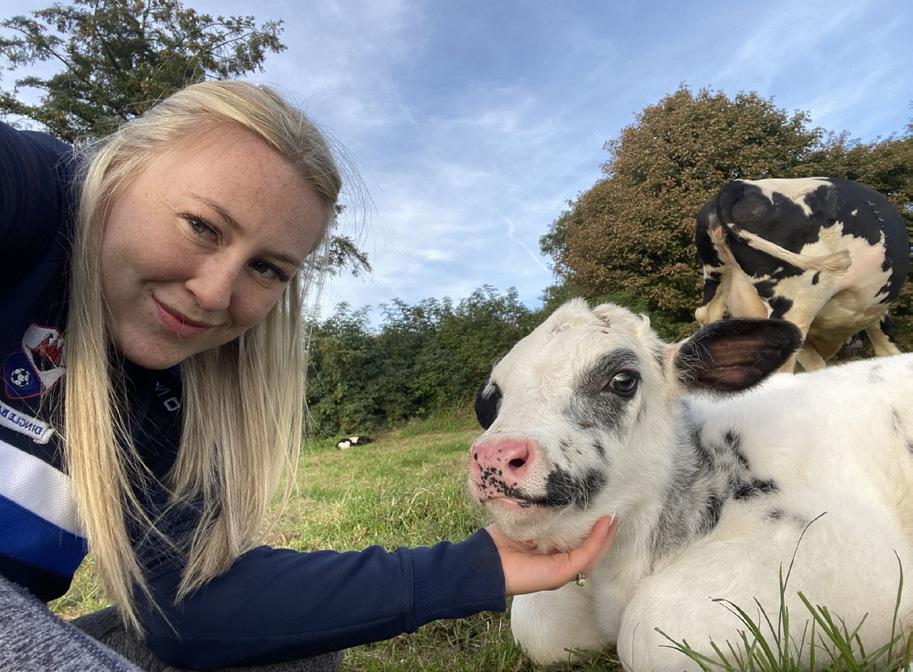
I completed a 12-week industry placement with LIC in New Zealand from May to August 2023.
With a long-standing interest in animal breeding and genetics, my involvement in Livestock Selection at LIC was a natural decision. Under the guidance of Bull Acquisition Manager Kelli Buckley, I worked as an intern researcher, engaging in various tasks within the Livestock Selection department.
My responsibilities included intensively selecting dams carrying the SLICK gene for participation in the slick trial managed by LIC Scientist (Quantitative Genetics) Esther Donkersloot, as well as selecting elite dams carrying the polled gene for inclusion in a polled mating program, where I gained valuable skills.
A significant aspect of my role was co-ordinating embryo matings, requiring meticulous record-keeping and communication with partners such as Vytelle and ABS. I established an efficient system for tracking these matings using Excel, which I created at the start of my placement. Additionally, I managed multiple matings for various clients within the Livestock Selection team, further expanding my expertise in this area.
My time at LIC, particularly within the Livestock Selection department, has been immensely rewarding. Working alongside dedicated professionals in a supportive environment has equipped me with essential skills for my future career and allowed me to develop personal growth.
This experience has solidified my aspirations, clarifying my vision for a future profession around animal breeding and genetics. My time with LIC was one of the highlights of completing my undergraduate education. I am forever grateful to LIC for this amazing opportunity, from which I learnt an abundant amount of knowledge, and gained skills that will benefit me in my future career.
I am currently conducting a research masters in reproductive biology at Teagasc, Moorepark. In the future, I hope to either pursue further research within this field or potentially work for an AI company on programs and IVF/embryo work similar to what I was doing with LIC.”
From May to August 2023, I took a 12-week industry work placement with LIC, in Hamilton, New Zealand as part of my agricultural science degree with University College Cork. I was attracted to LIC’s strong emphasis on research in areas that yield benefits for dairy farmers and strengthen the sustainability of New Zealand’s thriving dairy industry.
I was placed with the Research and Development team at LIC, under the supervision of Research Associate Gemma Worth and Senior Scientist Dr Lorna McNaughton, where I assisted with the ongoing SLICK project. This project aims to increase the welfare of animals during the heat of the summer. Heat stress is an increasing issue that’s exacerbated by rising global temperatures and can lead to negative consequences for animal welfare and productivity.
LIC discovered the location of the genetic variation causing the slick phenotype in cattle, originally found in Senepol cattle from St. Croix. The slick gene, linked to a short coat, enhances heat tolerance

and reduces cow’s susceptibility to heat stress. LIC is integrating this gene into New Zealand’s dairy population to offer dairy farmers heat tolerant genetics.
As part of this project, I took part in a trial examining the ability of animals with the slick gene to withstand colder temperatures. The cold sensitivity trials were undertaken at LIC’s Innovation Farm outside Hamilton, and involved exposing both slick and non-slick calves to cooler temperatures in a controlled environment, simulating conditions they would naturally face when born in a typical New Zealand winter.
This work was necessary to ensure that animals possessing the slick gene do

not have compromised welfare in cold conditions. During the trial, the calves’ core body temperatures, skin surface temperatures, and behaviour patterns were recorded and compared, both during exposure and after they had reacclimated.
This experience provided me with valuable insight into the design and implementation of live animal research trials, as well as a deeper understanding of the New Zealand dairy industry. My time with the LIC R&D team inspired me to pursue a career in research, and in July 2024 I began a PhD with Teagasc and University College Cork.
I thoroughly enjoyed my experience with LIC and would highly recommend this work placement opportunity to other students who are passionate about research, breeding, and the wider dairy industry.”
My time spent with LIC was a huge stepping stone in my future career in agriculture and I hope to return some day.
I’m a final year agricultural science student at University College Cork (UCC) Ireland. I come from a dairy farm background and have had the privilege to gain hands-on experience working with livestock over the years. In the third year, we are required to complete a 12-week industry placement alongside a 17-week farm placement.
I’d been to New Zealand for the previous calving season and was working on a dairy farm in Taranaki that had heifers in an embryo programme. This was my first introduction to LIC and sparked my interest in the vast world of genetics.
I started my internship in May 2024 and ended it in August 2024. I was working under the supervision of LIC bull acquisition
manager Kelli Buckley and the rest of the team in Livestock Selection. I was working on various tasks, all of which gave me the opportunity to see many different aspects of the company.
Some of my tasks included, TOP inspections, sire selection, bull inspections as part of the sire proving selection, bull to dam matings, assisting with the methane trial at LIC’s Chudleigh research farm in Tauwhare and so much more.
Starting this internship with LIC opened many doors for me. I always had the mindset that I’d return home to farm after my degree and felt that a job in the industry sector would not be suited to me as I’m so ‘hands on’. However, since the internship, and with the encouragement of Kelli and my other fellow colleagues, I’m considering continuing further education from May 2025.”

In recent years we’ve included a number of genomically selected bulls in our Irish offering. Initially the uptake was slow, but as these bulls have gained daughter proofs in New Zealand and Ireland, we’re seeing some increased usage as producers see the benefits of using LIC genomic bulls in their breeding plans.
In the past, some of our highest Breeding Worth (BW) daughter proven bulls have experienced lower initial EBI figures, in part due to difficulties in translating bull genetic merit estimates across countries. Yet consistently we’ve seen these same bulls producing cows that Irish farmers have been really pleased with, backed up by 5-star EBI herd reports.
Priests Sierra (ZSP), Priests Solaris-ET (PSQ), Bagworth PF Grandeur S1F (BGJ) and Savannahs HF Hammer S1F (SFZ) are all great examples of genomically selected bulls initially used in Ireland, that have proven to be crowd favourites.
The science also backs us up, with advances in LIC’s proprietary Single Step Animal Model (SSAM). Using all available genomic information in one single calculation step, the SSAM

delivers an 8% increase in genetic merit prediction accuracy when comparing genomic predictions to actual daughter proofs of the 2011, 2012, 2013 and 2014 cohorts of LIC’s sire proving scheme bulls.
NZ farmers now have more confidence in genomically selected bulls because of the improved accuracy of the SSAM. There has been a rapid increase in the use of genomically selected sires in NZ herds as farmers seek to capitalise on the faster rate of genetic gain delivered with shorter generation intervals, while using a team approach to balance re-ranking risk.
By the 2021 NZ breeding season, over half (50.3%) of the LIC straws used in NZ were from genomic bulls – this is a significant increase from 12.6% in 2016. This confidence has been hard won, thanks to the efforts of LIC’s world class R&D team.
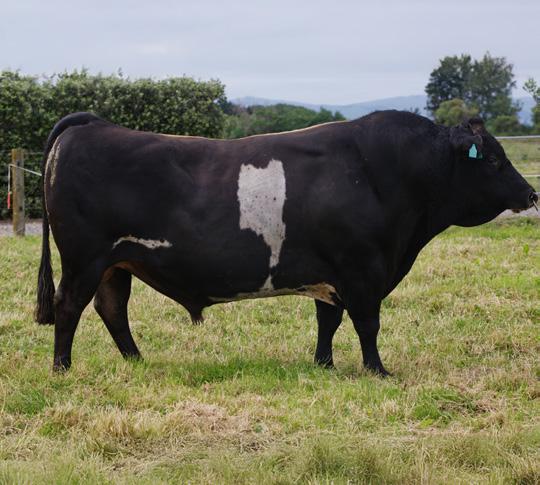
Over the past three decades, LIC has invested more than $80 million into genomic science and genome sequencing technology. This has generated gains in productivity, and health traits for dairy cows, better returns for dairy farmers and improved environmental efficiency.
Genomic selection is now a key part of LIC’s breeding scheme in conjunction with the more traditional methods of our sire proving scheme. Cows that have both phenotype (milk recording data) and genotype information create a ‘reference population’. The bigger and more representative the reference population is of the national herd, the higher the accuracy of genomic evaluation.
A large relevant reference population is important for any genomic estimation model, and New Zealand’s predominantly crossbred dairy population is unique. By comparison, most overseas reference populations are specific to a single breed. Understanding the gene interaction between the Holstein, Friesian and Jersey parent breeds is a key part of LIC’s across-breed genomic evaluation system.


The New Zealand genomic journey started in 1994 when the gene discovery programme began. By 2008, approximately 5,000 sires were genotyped, and young bulls were first marketed based on their genomic information.
During the last 16 years, significant advancements in research and technology have led to the launch of GeneMark® Genomics, a cost-effective and highly accurate genotyping platform for female animals.
By April 2024, approximately 380,000 animals have been genotyped on the LIC platform. By late 2024 it’s expected this number will approach 1 million. This technology allows LIC to add a significant amount of genomic data into the LIC genomic evaluation model.
There’s a great opportunity for Irish farmers to take advantage of this, by including genomically selected high BW bulls in their selections this coming spring. LIC Ireland prides itself on offering the best daughter proven bulls from NZ, so why not add in some of the best genomically selected high BW bulls this season as well.
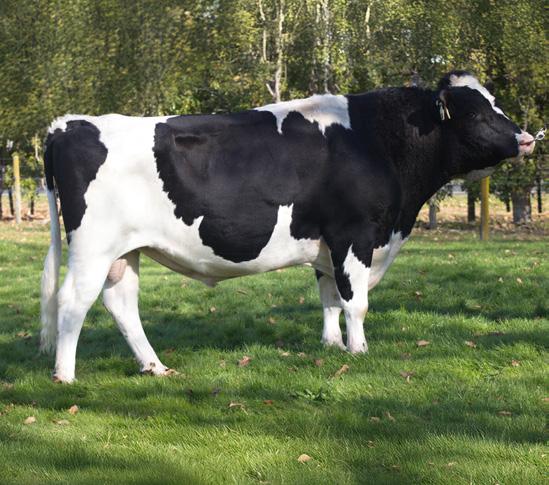

One of the most important jobs on a dairy farm is developing a breeding strategy and selecting which bulls to use across the herd. But too often it’s a task that doesn’t receive the attention it deserves.
Unlike some factors that are out of a farmer’s control, this is one you do have control over and it’s especially important because it can affect farm profitability. All it takes is being organised and adopting a proactive approach by thinking about breeding decisions early and having a plan in place before the busy spring season.
February to May each year is a time to focus on keeping cows and calves healthy, getting cows out to grass, and setting the farm up for the rest of the milking season. Every effort needs to be made to reduce workload. It’s fair to say that the spring of 2024 was a difficult one, and spending the time to sit down and make decisions on what genetics to bring into your herd was next to impossible.
This is why we encourage farmers to contact LIC once cows start going into late lactation, and before entering their dry period. Consistency is the key to herd improvement, and the only way to achieve this is to be very clear on what you want from your herd.
Our team can sit down with individual farmers and help develop clear goals. Identifying the top performing cows in the herd and selecting the most suitable bulls to help meet the farm’s objectives.
This year at LIC, we’re uniquely positioned to have the vast majority of our product for the upcoming season in Ireland before December. This milestone is the result of several years of planning.
Due to EU regulations, all semen
destined for the Irish market in New Zealand must be collected at our EU centre in Awahuri, based in the Manawatu region in the lower part of the North Island. For years, this presented a significant logistical challenge, with bulls collected for the Irish market also generally in high demand in New Zealand.
This required careful coordination to ensure the bulls arrived at Awahuri in time to collect enough semen for the Irish market. However, a lot of effort has been invested in streamlining the process by transitioning Awahuri to year-round semen collection. Bulls are being left on-centre for longer and this has enabled us to supply a steady stream of product throughout the year, instead of attempting to supply the whole season’s stock justin-time for the breeding season.
As a result, this change has greatly improved our supply chain efficiency.
What does this mean for Irish farmers? It means good news. In previous years, shipments from New Zealand may have arrived later than anticipated, impacting the tight window to deliver semen to farmers in time for their breeding season.
With most of the product now already in Ireland, customers who purchase their semen early can have peace of mind that it will be in their tanks well before breeding starts.
Given all these factors, the rationale behind making early decisions around your breeding choices for the upcoming season is well-founded. To ensure you make the best choices and secure your product, get in touch with our team for expert advice.




Earlier this year, Dara Killeen won the top award from his co-op Aurivo, building on his previous accolade of being named Ireland’s top Young Farmer in 2021. Although he’s only in his sixth full year of milking, Dara is determined to make consistent decisions that result in the best returns.
“I don’t go for extremes, I just try to get things right,” he says.
Farming a 300-acre all grass unit at Bawnmore Farm, Eyrecourt, Co Galway, Dara milks 150 crossbred cows, comprising 75% Friesian and 25% Jersey. Of the total acreage, approximately one-third is farmed under an environmental scheme and is exclusively grazed by his two-year old heifers from May to September.
Winning the Young Farmer title was a big achievement for Dara, achieved in just his second year of milk production. Adding to this triumph, the Aurivo award in 2024 has firmly put him on the Irish dairy map. “I feel the co-op award recognised the image that dairy farming is good.” Dara added, “We have a lot of critics out there, and this award was based on everything – my production, utilisation of grassland, environmental measures and so on.”
Dara is the 4th generation to farm at Bawnmore, the unit has been in the family for many years. “I started to take over
management in 2017, at the start of the dairy conversion. I had farmed with my father for five or six years by this point where we had sheep and beef cattle, and I had spent six months in New Zealand in Invercargill working on a dairy farm with contractors.
“At that time there was a big push from the EU looking for Ireland to ramp up milk production, and they made it really easy for us. Finance was accessible, there were no quotas, there were no barriers in our way at all,” explains Dara. “But fast forward to today, it’s a lot more complicated, there’s our nitrate derogation, higher interest rates, fertiliser register, and input costs are still too high” Plans began in 2017, with Dara driving the vision for the future farm. He decided what financial investment was needed, identified the buildings and equipment that needed to be purchased, and
decided on what stock to buy. “My dad was probably at the point where he wanted to take a step back, so we did a farm transfer”.
Dara began buying weaned calves in 2017, putting them in-calf in May 2018 and calving them down in 2019. In his first year, he milked 100 cows, increased to 100 cows, increasing to 130 in the second year and 150 in the third. During the fourth and fifth years, he milked 160 cows, reducing back to 150 in this his sixth year.
“Last year the spring was horrendous and there was virtually no feed left in any yard in the country. With fertiliser registered now, we’re limited to how much nitrogen and phosphorus we can spread, so a lot of farms are finding they’re not able to grow the same level of grass that they have in the past.
“I’ve been feeding the cows off my own grass production, topped up with 750 kg of meal at a stocking rate of 3.6.
“This year I’m trialing a slightly lower stocking rate and built up a good supply of feed for winter, while trying to reduce my costs over the course of the year. I said I would try it for one year and see how it goes. It was only a drop of 10 cows, so wasn’t a massive jump either way.”
“I went through my profiles and picked off the 10 worst performers. But for peak month of May, we very nearly sold the same amount of milk from less cows. A lot of the co-ops are down on milk. Some of them by as much as 12%. I’m down by 6%.
Dara states “The weather’s been a bit harsh, yet we’ve had a lot of rain recently. This is a very, very dry farm and now our grass is looking very good. I think we’ll have a very strong back end to the season. So, even with 10 less cows, I’d be hopeful that we’ll match last year’s production at least.”
The farm trialed a 10 in 7 milking structure in the months of September, October and November 2023. As a result, the cows were a little bit fat calving down in spring 2024, leading to a few more milk fever cases than normal. “Moving to this milking system has led to a loss of about 10 kg milk solids per cow/year, but we’re currently averaging 475 kg in this year, up from 465 kg,” he says.
The oldest cows in the herd are now eight years old, and in their sixth lactation. This year, Dara weighed his whole herd for the first time, allowing him to study his herd’s efficiency in greater detail. From this data, it showed his heifers weighed an average of 420 kg, second calvers were 473 kg and the older cows weighed 570 kg, giving an overall average of 506 kg.
His predicted percentages suggest he will end the lactation with an average of 4.84% fat and 3.93% protein. “They definitely have the potential for 500 kg of milk solids, but we’re not there yet. What’s holding us back? Our proteins over the summer.
“It’s very hard to maintain grass quality here in June and July, being such a dry farm. August isn’t too bad, but we are definitely being held back.”
Restrictions on nitrogen use are making Dara look at adding more clover into the swards, by oversowing on productive paddocks and full reseeds on ones growing lower tonnage.
At the moment, his replacement rate stands at 20%, up from the previous 10 to 12% as the herd has aged. “This is the first year where we’ve used 100% sexed semen straws. No conventional dairy semen was used.
“We targeted to breed 45-50 females. That allows 30 for our own herd, and any excess sold through the local market.
“We used 100 sexed straws. The plan was that we’d get just over 50% conception, with 10% of them being bulls. This would provide us with around 45 dairy heifers. Across the board we had a 60% conception rate with the cows, and 10% empty on just over an 8 week breeding season. I was happy with that.”
Dara selects proven bulls that offer high fertility and milk solids: “Proven bulls are consistent. You know what you’re going to get,” he says. Using LIC semen exclusively he’s focusing on Flash Gordon, Dowson Whakatupu, LIC Hustler, and Backdrop to maintain a 75% Friesian and 25% Jersey animal.
When aiming for efficiency, what does Dara look for?
“Fertility is a big one for me. After that we want to get our kg of milk solids from our fat and protein, so it’s just trying to increase the solids in the herd. We have the litres there, with the yield currently at 5400 litres.
“Weighing the cows will enable me to make more informed decisions when selecting animals for culling. We’re targeting 500 kg of solids or in excess of that with a herd average weight of 506 kg.
“I can see the value in having a more even herd because I just think that, while a smaller cow might match her liveweight in solids, she just won’t have enough output to pay her bills.


“If you have a heifer or a cow that’s under 400 kg and she’s doing 400 kg of milk solids, it’s just not enough for the system we’re in. We couldn’t get our cost structure low enough to justify that level of output.”
Dara also believes milk recording is key to hitting efficiency levels in the longer term.
“When you really dig into the figures, there’s definitely some cows that are eating a lot of feed, and they’re not giving that value back to you. We’ve just had our third milk recording done this year, so that’s going to give me a better reflection on the year-to-date. “
Dara feels well-positioned for the future, farming primarily owned land and having made significant investments, including the recent slurry project all financed through cash flow. He completed the new 230,000-gallon storage tank this summer, which will allow more flexibility next spring as he will be able to store slurry for longer periods if the weather is poor and when the closed season for spreading has ended. (The legal requirement for his region is to have 18 weeks, this new tank allows for 22 weeks storage).
“Our farm is quite resilient, and our cost structure is low. We don’t feed too much meal, we use contractors for much of the farm work, and we’re positive about the future. Flexibility is one of the most important attributes to have right now, and we have that in abundance!”.

“It’s my biggest pain in life,” Eamon admits, reflecting on the time lost and the stress it creates. This was one of several issues that prompted him to seek out different ways to manage the cows.
One significant hurdle is that some 57 acres of their farm is rented land. Eamon says that if he owned that portion, he wouldn’t hesitate to invest in a tunnel to make his daily routine much easier.
He owns 85 acres of the farm total, with half of this as the milking block and half a support block. Some two years ago he was lucky enough to buy a further 12 acres of adjoining land which backed on to the original block.
Over the past decade, their herd has shifted from being entirely Holstein Friesians to mostly Jersey crosses, by steadily crossing all the cows with pure Jersey. He then moved to using LIC’s KiwiCross® bulls and today is using New Zealand Friesians, appreciating their ability to provide volume as well as high milk solids efficiently from grass.
“I’m going back to the New Zealand Friesian to get a bit more size really,”
With a 154-acre farm based outside Loughrea, Co. Galway, Eamon and Caroline Connaughton navigate the interesting challenge of having four different roads crossing their property. In particular, they often find themselves spending over an hour each day waiting for their 142 milkers to safely cross the road.
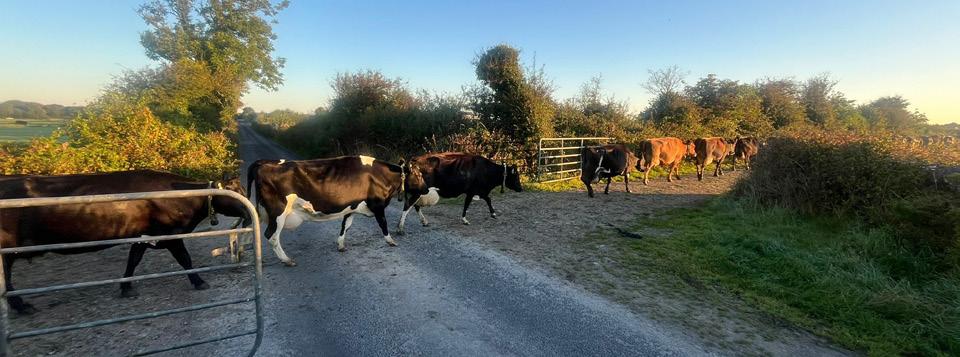
explains Eamon, “but after two rounds I will probably go back to pure Jersey again. I want to increase volume and get a bit more milk at the back end.”
Yield at the moment is sitting around 4,300 litres with total milk solids of 400 kg/ cow. The cows weigh, on average, 550 kg so he knows he has an opportunity to increase milk solids. “My target is to get to 450 kgMS, and I’m going up a bit every year with careful bull selection.”
On his heifers he’s been using Homebrew, Premonition and Professional, and on the cows Darius, Equator, Trapeze, Backdrop and Kauri.
He rears around 40 replacements each year and has used sexed semen for the past two years, using this on his best cows to move his genetics forward as quickly as he can. The heifer replacements go to his brother Colm to rear, and the beef calves are sold.
Interestingly, Eamon made the decision to go once-a-day milking around five years ago, after looking at his options for two years prior.

Originally farming with his father, they were producing around 50,000 gallons from their 40 cows. He later joined a local discussion group and learnt that a group

of compatriots didn’t feel that producing more liquid milk was the future. “At the time I think we only owned 80 acres, with the land divided into two 40-acre blocks, but then I got the chance to rent 50 acres next to us.
“We’d been all-year-round calving but switched over to spring calving and started to introduce Jersey to increase the solids and improve fertility.” Eamon adds, “With spring calving, we could see the benefit of helping with our workload and giving ourselves some time to get away. It gave us peaks at calving time, but troughs at the end of the year.”
Within the discussion group Eamon began to see a move away from the bigger Holstein to a more robust, smaller, NZ animal that was proving to be very efficient and able to produce plenty from grass. He also found he was able to improve fertility within the herd.”
He says switching to spring calving and stopping winter milk production was a bigger challenge than moving to oncea-day. “We were just about being paid enough to supply through the winter, but they weren’t paying enough for your labour over that period – over Christmas and the New Year, for example. That’s the way I was looking at it.
“The first year I worked on the maths, and I actually earned more money with spring calving. The costs were gone from working through the winter, which was the hardest and most expensive milk to produce.
“But to dry the cows off was a big thing at the time. Suddenly I didn’t have to get up in the morning from December through to February.”
Eamon made the decision to switch to once-a-day shortly after he took on a further 40 acres across the road. He reflected on the decision at the time, but felt relieved he’d made it, as shortly afterwards, he lost the lease on another 50 acres he had hoped to keep renting.
He thought he had an opportunity to increase cow numbers, but with the loss of this land he had to reduce numbers fairly dramatically or move to once-aday milking. That loss made the decision easier, as he didn’t have a lot of time to think about it.
“To start with I wondered whether I would be better off financially to keep more cows and attempt to milk from that land. But being across more roads and a mile away, along with needing some improvement, the decision was made to go once-a-day.”
This land is split into seven 5-acre paddocks and is grazed at least once before silage is taken. “The cows only have to walk there once a day, and with the extra silage I made, I feel I’m much more self-sufficient,” he says. “I try to remain flexible and graze the cows where it’s most efficient.”
Poor weather since the autumn of 2023 has led to sporadic grass growth, and a greater reliance on bought-in feed. However, as the summer of 2024 progressed, Eamon noticed improved grass growth and better quality. With winter approaching, he believes he is ahead of his targets and feels more comfortable about his feeding plans.
The cows are milked through a 14-unit swing-over parlour, and at times Eamon finds himself standing on one of the roads for up to an hour, as the cows make their way into the yard.
“To be honest it still takes me too long. In the spring, during the peak, it can take between two-and-a-half to three hours. So going once-a-day was a no-brainer really once I made the decision.
“The cows go out from the first week
of February, and come back in midNovember, depending on the weather. Drying off starts in October, and I try to keep them outside for a few days after they’ve dried off when possible.”
Does Eamon think that switching to once-a-day has worked financially?
“I suppose the decision was pushed on me once I lost the 50-acre block of leased land, but I would say it has, most definitely. We may have lost some milk solids, but we’ve made huge savings in work and feed costs over the winter.
“We’re getting around 400 kgMS per cow now and we were around 450 kgMS/cow. Cost control is a lot easier, and my work/ life balance is much better.
“Do I wish I had made the switch earlier? Yes, definitely. I didn’t think so at the time, but it’s very true that as one door closes, another opens.
“I do think the type of cow you have makes a big difference. The Jersey is a great animal and crossed with a Friesian you’ve got a hardy animal that maximises milk from grass.
“Financially, if you keep a good handle on your costs, there’s a good living to be made from once-a-day. I haven’t regretted my decision for a minute.”
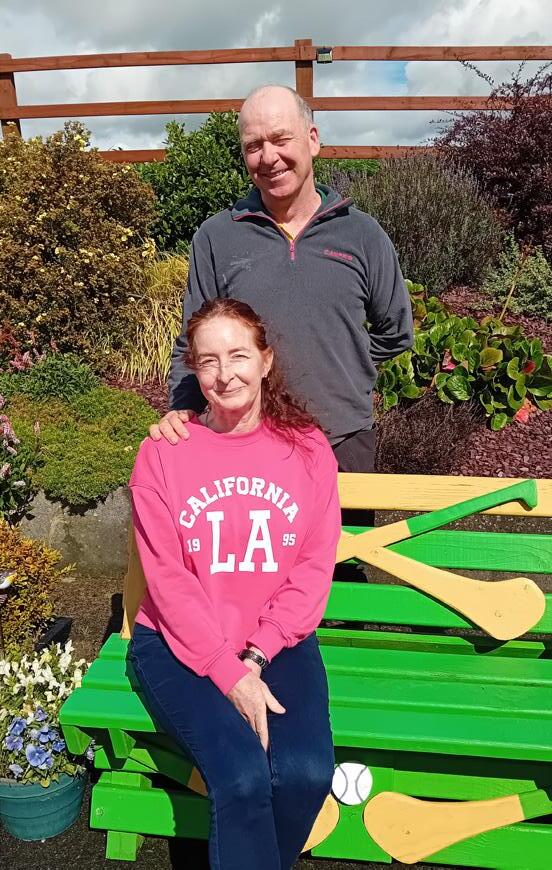

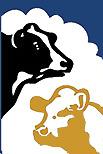







MARK RYDER
General Manager - LIC Europe
T +44 78 2731 7331
E mryder@liceurope.com
d AI Services (NI)
T 028 9083 3123
Lt
F 028 9084 2640
E info@ai-services.co.uk
DAVID POWER
Genetics Dev Mgr - Midlands South East
T 087 937 2553
E dpower@liceurope.com
EOIN KENNEDY
Breeding Advisor - Midlands South East
T 086 410 7786
E ekennedy@liceurope.com
WILLIAM WALSH
Breeding Advisor - Cork & South Tipperary
T 086 174 5666
E william@eurogene.ie
BARRY O’DONOVAN
Breeding Advisor - West Cork & Kerry
T 087 399 5967
E barry@eurogene.ie
LEONARD GAVIN
Breeding Advisor - Midlands North, East & West
T 086 142 8830
E lgavin@eurogene.ie
PADRAIC HARNAN
Breeding Advisor - Midlands North, East & West
T 086 191 6076
E padraic@eurogene.ie
PAT CORCORAN
Breeding Advisor - Kilkenny, Laois & Limerick
T 086 206 2808
E pat@eurogene.ie
Carrigeen Commercial Park
Cahir, Co Tipperary, Ireland
T 052 744 2517


ANGELA KENNEDY
Telesales
T 052 744 2517
E angelak@eurogene.ie
MAIREAD HAYES
Telesales
T 052 744 2517
E mairead@eurogene.ie
Carrigeen Commercial Park
Cahir, Co Tipperary, Ireland
T 052 744 2517